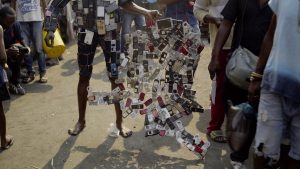(THIS ARTICLE IS MACHINE TRANSLATED by Google from Norwegian)
Fair Party is a film about the capital of Congo, Kinshasa, and about the city's performance artists, who use the capital as an opportunity space to confront and rewrite its history (s). They take matters into their own hands and refuse to let the legacy of colonial times and colonialism distort the truth or get the last word when it comes to defining the citizens' identity.
The artists' gripping and multifaceted interventions are documented by four filmmakers: two Congolese (Paul Shemisi and Nizar Saleh) and two Belgian (Anne Reijniers and Rob Jacobs). Together, they are working to find a new way to present Kinshasa. They have "a common past", it is said, "and therefore also a common present". Their different perspectives on the Congo as a former Belgian colony provide a new basis for the interpretation of history. They explore innovative methods of staging Kinshasa, previously reduced to a "hungry, filthy, weeping city" in countless stereotypical portrayals. The format is loosely episodic and is characterized by a do-it-yourself attitude, trial and error. It fits well with a movie that embraces play and experimentation as a way of reconstructing narratives, but also with the notion that a city's collective history is an active and dynamic process.

Street theater as an intervention
"The tin-box man is here!" A man yells in the street as a sensational creature, completely covered with soda boxes, shakes his body to a drum beat. A suit of condoms that a performance artist wears in one of the city's prostitution areas, and a suit of cellphone parts are other impressive examples of political outfits made in public. Together, the artists focus on challenges related to health, consumption and resource utilization. The flags of countries that drain Africa for mineral resources, including the UK and the EU, are washed in a large tub by an artist of great standing before waving the flags in front of the crowd that has gathered. The performance is a kind of symbolic cleansing of the corruption the countries represent. The artists are also fighting for women's rights with a performance that shows the victory of black-clad, masked "rapists" and culminating in a call for the objectification of women. These are just a few examples of the street interventions we see in the film, where Kinshasa emerges as a city of thriving creative transformation. "Congo is a perpetual theater," we hear – an ironic leap to the country's decades without reliable democratic elections.
It is told how Belgian Police Commissioner Gerard Soete parted Lumumba's corpse with a building file and dissolved it in sulfuric acid.
A tribute to Congo's liberation hero. The art performances on the street come in many different expressions and forms, but a pervasive theme is the tribute to Patrice Émery Lumumba. Lumumba was a liberation advocate who became the first prime minister of the independent republic of Congo in 1960. He helped the country with the release of the Belgian colonial government until it was overthrown in a coup, imprisoned and eventually executed by shooting. In one of his tributes, Lumumba's texts about justice, dignity and freedom are read aloud on a street corner while a poker player hands out cards – a mirror of Congo as a large casino, where foreign powers come to gamble and loot.

The performance group also creates a giant gold tooth in cardboard masks and takes it as a sacrificial gift to the statue of Lumumba in one of the city's parks. A bell is ringing to indicate that they have arrived, and then a speech is presented that reproduces the facts of Lumumba's history while curious passersby look. It is told how Belgian Police Commissioner Gerard Soete parted Lumumba's corpse with a building file and dissolved it in sulfuric acid. He should then have pulled out two gold teeth from his mouth to keep them as souvenirs. A parallel is drawn to the Greek myth of Jason and the Argonauts, where an army grows out of the teeth of a dragon.
In this way the colonial powers' deeds and condemnations are kept alive in Kinshasa's collective memory; memories are woven into the city's diverse identity, but are emerging as sources of future strength.
Political representations
Among all these startling, eccentric and satirical performances, we hear conversations between filmmakers and the city's inhabitants, and their political reflections on who is allowed to portray the city and in what way. The blockbuster movie from Marvel's superhero universe Black Panther (2018) and the Kingdom of Wakanda – utilized for its resources – are often hailed as a history of parallels to the Congo, which is exploited for its mineral resources. At the same time, it is noteworthy that the stories and legends of the region are presented from the outside, rather than being told and disseminated directly from the source. We are told that Congo does not value its own film production, while Belgium has provided financial support for this documentary. It all gets pretty self-referential, but taking the matter into your own hands and yelling that things need to change may be a call to other directors?


